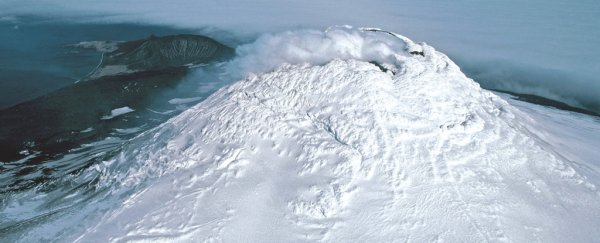When we think about volcanoes, we tend to conjure visions of bubbling pools of molten lava ready to consume anything that ventures too close.
The reality is a bit different. Such terrifying lava lakes do exist, but they're a lot rarer than you might imagine. Only a handful of persistent lava lakes exist among the estimated 1,500 potentially active volcanoes around the world – and this fiery cohort just welcomed a new member to their ranks.
Scientists from the UK have identified what is only the 8th known persistent lava lake in the world, seething inside the active volcano Mount Michael sitting atop the remote Saunders Island in the sub-Antarctic South Sandwich Islands, buried at the southernmost fringes of the South Atlantic.
Volcanic activity at Mount Michael has been documented for almost 200 years, but the extreme remoteness of the island – and its challenging physical environment – make field investigations up close a difficult (if not impossible) task.
 False colour satellite image of Saunders Island and the lava lake within the crater of Mount Michael. (BAS)
False colour satellite image of Saunders Island and the lava lake within the crater of Mount Michael. (BAS)
"The island has been visited on numerous occasions, but no-one has ever climbed the mountain," geospatial analyst Peter Fretwell from the British Antarctic Survey (BAS) told the BBC.
"If you look at the imagery you can see why: the peak is surrounded by a huge snow-mushroom, extremely soft snow with an icing-sugar-like consistency, probably caused by the continual venting of steam by the volcano."
According to Fretwell, this soft, treacherous terrain would make expeditions in person to assess the volcano impractical, not to mention unadvisable.
"You cannot walk over this," he said. "You would have to dig through it, but taking the time to do this on such an active volcano would be dangerous."
Despite the hurdles, there's long been an impetus to know more about what's been going on under Mount Michael's steaming hood.
Thermal anomalies at the volcano were detected by satellite in the 1990s, but the readings weren't indicative of magma overflow spilling out from the crater, potentially suggesting the existence of a lava lake.
In contrast with temporary 'lava pools' (which only swell up during periods of eruption), lava lakes are an enduring feature that can last beyond a single eruptive episode, in some cases for up to 100 years.
In a new study, Fretwell and fellow researchers examined newer, higher-resolution satellite imagery recorded in Landsat, Sentinel–2 and ASTER data between 2003 and 2018.
A thermal analysis of the shortwave infrared (SWIR) data identified a lava lake underneath Mount Michael with an estimated width of 110 metres, and molten lava temperatures reaching as high as 1,279 °C (2,334 °F), although the average heat of the overall volume is cooler due to heat dissipation at the crust.
It's a remarkable find, but the bigger long-term impact might be the new analytical techniques developed to discover this "extremely rare" formation.
"Identifying the lava lake has improved our understanding of the volcanic activity and hazard on this remote island, and tells us more about these rare features," BAS geologist Alex Burton-Johnson explains in a press release.
"And finally, it has helped us develop techniques to monitor volcanoes from space."
The findings are reported in Journal of Volcanology and Geothermal Research.
